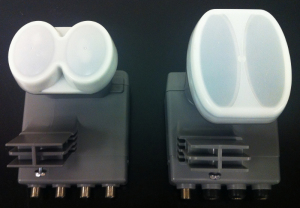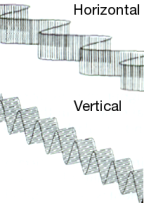
When your dish receives signal from the satellites in orbit, the signal must be converted
into something your receiver can unscramble. The device that is used to
accomplish this is called a “low noise block-amplifier feedhorn,” or
LNBF. This is positioned at the end of the dish support arm. There are a
few different types of LNBFs available, but there are two main ones we
currently use: a quad LNBF, or xKu LNBF.
The LNBF receives the raw signal directly from our satellites – Anik F1R, Anik F2, and soon Anik G1 – and amplifies the signals. It then changes the frequency before the signals make it to your receiver. It will split the signal up into different polarization and frequency.

Shaw Direct uses two polarities for our service – horizontal and vertical, which both require a different electric voltage to activate (10.5 to 14.2 volts for vertical, and 15.2 to 21.0 volts for horizontal). Each polarity has a different range of electromagnetic wave frequencies that all of the channels are transmitted over. Channels are “stored” on areas of the satellite called “transponders,” each of which has a unique frequency.
As we currently have two satellites in orbit, a quad LNBF will allow for the four polarities to be received (namely the horizontal and vertical on Anik F1R, and the horizontal and vertical on Anik F2). When our third satellite is launched, we’ll need to use the new xKu LNBFs to receive the extra two polarities from Anik G1.
While “quad” refers to the number of polarities that can be received, “xKu” refers to the extended Ku-band that Anik G1 will use. The normal Ku-band that Anik F1R and F2 use is a portion of the electromagnetic spectrum in the microwave range of frequencies. The extended Ku-band just uses a slightly larger spectrum than Ku.
If you’re ever wondering if your LNBF is working correctly, there are a few simple things you can do to find out. We always want to make sure that you’re able to receive channels from both of our current satellites, and each polarity, so you can check out the following channels:
| Satellite | Polarity | Classic Channel Number | Advanced Channel Number |
| Anik F1R | Vertical | 299 | 299 |
| Anik F1R | Horizontal | 300 | 058 |
| Anik F2 | Vertical | 350 | 070 |
| Anik F2 | Horizontal | 700 | 700 |
You might not be subscribed to all of those channels, but the front panel of your receiver will tell you what you need to know. If you have one of our 6XX-series receivers, look for a little red light; if it’s on, your receiver isn’t getting signal for that channel. If you have any of our other receivers, look for a light shaped like a tiny satellite dish; if it’s red, you have no usable signal.
Once you’ve checked, you can use your results to help figure out the issue. If you’re missing both channels from Anik F1R or F2, both vertical channels, or both horizontal channels, it’s possible that you may need a replacement LNBF. If this is the case, give us a shout and we will be happy to help you!
*rg
